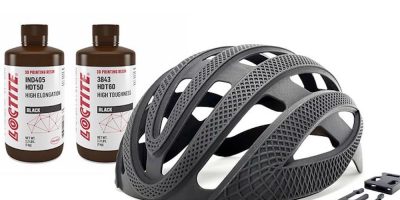Desktop Metal and Henkel validate 3D printing workflow
Desktop Metal and Henkel have announced the first initial workflow validation for the Xtreme 8K, the largest digital light processing (DLP) build volume machine for the 3D printing market. Following the two companies’ collaboration on applications on ETEC’s printer platforms for industrial and medical use, validation of Henkel’s Loctite branded formulations shows support from both partners for volume production in additive manufacturing.
A workflow specific to the machine and material achieves optimal and repeatable results. Loctite 3D Printing has pioneered the sharing of detailed workflows developed specifically to the machine and material. The workflow validations provide complete specifications for printing, curing, and cleaning parts printed with Loctite materials.
Desktop Metal acquired ETEC in 2021 and Loctite has already validated several materials on the ETEC Envision One printers. Validated products include Loctite 3D 3955 HDT280 FST, claimed to be the first 3D photopolymer material that passes vertical burn and aerospace FST standards with an HDT (heat deflection temperature) of less than 300 degrees C. This halogen-free flame retardant material with UL94-V0 rating delivers extremely high HDT and tensile physical properties.
Another validated material is Loctite 3D IND406 HDT100 High Elongation. The material has all round strength, good impact resistance, high elongation and an HDT of above 100 degrees C.
Loctite 3D IND402 A70 High Rebound is an elastomer with high elongation and energy return that does not require additional thermal post-processing.
The onboarding of photoplastic and photoelastic single part materials on the Envision One printers allowed users to print highly viscous and solid resins.
The Xtreme 8k is claimed to offer the world’s largest production-grade DLP 3D printer for high volume production of end use parts. The Xtreme 8k uses top down printing to allow for faster curing of each layer, high-power projectors, and a custom optical train to ensure high power is delivered to each voxel. This combination means that the large format 3D printer allows the production of large 3D parts without sacrificing quality or accuracy, explained Henkel.
Combining Henkel’s material expertise and ETEC’s advanced printer hardware allows for the adoption of end use 3D printed parts. Build volume is 450 x 371 x 399mm, allowing users to take advantage of the increased manufacturing capacity of over 150 litres of resin. Coupled with Loctite 3D photoplastic resins, customers can quickly produce tough and durable end-use parts with surface finish and premium mechanical properties, said Henkel.
Two Loctite branded photopolymer materials have been initially validated on the Xtreme 8K machine. These are the Loctite 3D 3843 HDT60 High Toughness ABS-like engineering plastic, exhibiting impact resistance. The second is Loctite 3D IND405 HDT50 High Elongation- is tough PP-like engineering plastic with impact resistance and “excellent surface finish properties”.




